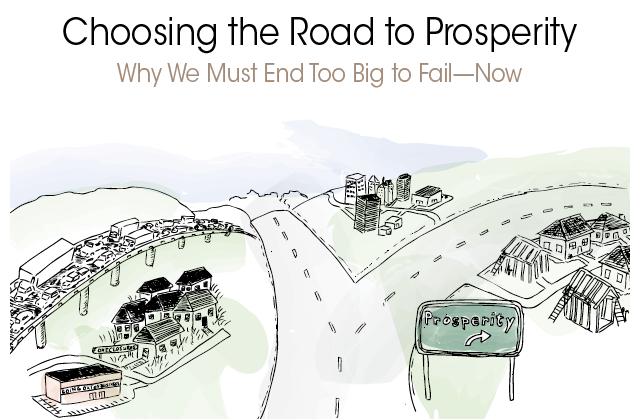Choosing the Road to Prosperity – Why We Must End Too Big to Fail—Now
The too-big-to-fail institutions that amplified and prolonged the recent financial crisis remain a hindrance to full economic recovery and to the very ideal of American capitalism. It is imperative that we break up the big banks.
Here’s the full letter from Dallas Fed President Richard Fisher, generally known as one of the most hawkish and conservative Fed Presidents.
Letter from the President
If you are running one of the “too-big- to-fail” (TBTF) banks—alternatively known as “systemically important financial institutions,” or SIFIs—I doubt you are going to like what you read in this annual report essay written by Harvey Rosenblum, the head of the Dallas Fed’s Research Department, a highly regarded Federal Reserve veteran of 40 years and the former president of the National Association for Business Economics.
Memory fades with the passage of time. Yet it is important to recall that it was in recog- nition of the precarious position in which the TBTF banks and SIFIs placed our economy in 2008 that the U.S. Congress passed into law the Dodd–Frank Wall Street Reform and Consumer Protection Act (Dodd–Frank). While the act established a number of new macroprudential features to help promote financial stability, its overarching purpose, as stated unambiguously in its preamble, is ending TBTF.
However, Dodd–Frank does not eradi- cate TBTF. Indeed, it is our view at the Dallas Fed that it may actually perpetuate an already dangerous trend of increasing banking industry concentration. More than half of banking industry assets are on the books of just five institutions. The top 10 banks now account for 61 percent of commercial banking assets, substantially more than the 26 percent of only 20 years ago; their combined assets equate to half of our nation’s GDP. Further, as Rosenblum argues in his essay, there are signs that Dodd– Frank’s complexity and opaqueness may evenbe working against the economic recovery. In addition to remaining a lingering threat to financial stability, these megabanks signifi- cantly hamper the Federal Reserve’s ability to properly conduct monetary policy.
They were a primary culprit in magnifying the financial crisis, and their presence continues to play an impor- tant role in prolonging our economic malaise.There are good reasons why this recovery has remained frustratingly slow compared with periods following previous recessions, and I believe it has very little to do with the Federal Reserve. Since the onset of the Great Recession, we have undertaken a number of initiatives— some orthodox, some not—to revive and kick-start the economy. As I like to say, we’ve filled the tank with plenty of cheap, high-octane gasoline. But as any mechanic can tell you, it takes more than just gas to propel a car.
The lackluster nature of the recovery is certainly the byproduct of the debt-infused boom that preceded the Great Recession, as is the excessive uncertainty surrounding the actions—or rather, inactions—of our fiscal au- thorities in Washington. But to borrow an anal- ogy Rosenblum crafted, if there is sludge on the crankshaft—in the form of losses and bad loans on the balance sheets of the TBTF banks—then the bank-capital linkage that greases the engine of monetary policy does not function properly to drive the real economy. No amount of liquidity provided by the Federal Reserve can change this.
Perhaps the most damaging effect of prop- agating TBTF is the erosion of faith in American capitalism. Diverse groups ranging from the Occupy Wall Street movement to the Tea Party argue that government-assisted bailouts of reckless financial institutions are sociologically and politically offensive. From an economic perspective, these bailouts are certainly harmful to the efficient workings of the market.
I encourage you to read the following essay. The TBTF institutions that amplified and prolonged the recent financial crisis remain a hindrance to full economic recovery and to the very ideal of American capitalism.
It is imperative that we end TBTF. In my view, downsizing the behemoths over time into institutions that can be prudently managed and regulated across borders is the appropriate policy response. Only thencantheprocessof “creativedestruction”— which America has perfected and practiced with such effectiveness that it led our country to unprecedented economic achievement— work its wonders in the financial sector, just as it does elsewhere in our economy. Only then will we have a financial system fit and proper for serving as the lubricant for an economy as dynamic as that of the United States.
Full report below…
~
4closureFraud.org
~
Choosing the Road to Prosperity – Why We Must End Too Big to Fail, Now


The TBTF’s failed to hold up their end of the bargain with bailouts and undermined our economy by choking off credit and failing to work with homeowners and failing to invest in our local economies to the degree they should be. Dodd-Frank could have been much stronger if the lobbyists, possibly the Fed’s, didn’t weaken it. Will be interesting to see if Fisher isn’t just pushing more de-regulation though breaking up the monopoly of the TBTF’s is exactly what’s needed and is a strong statement.